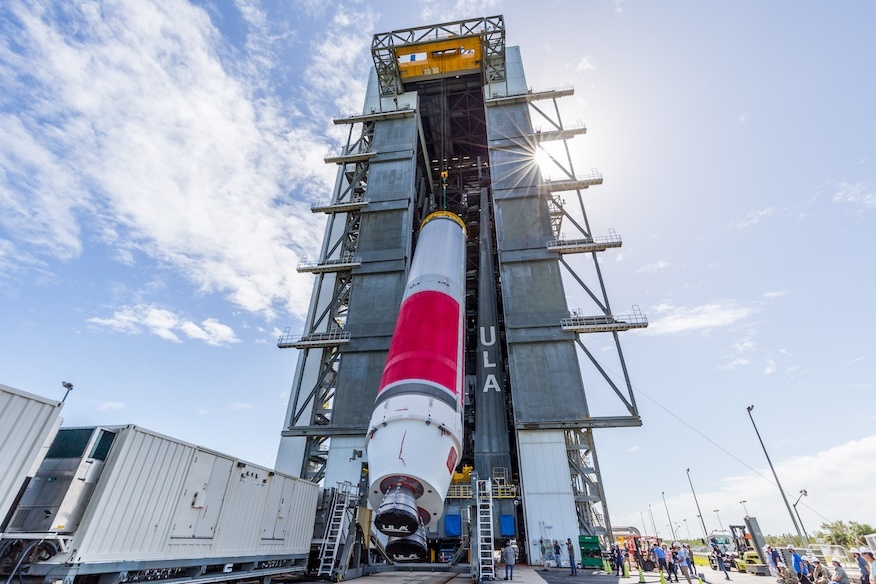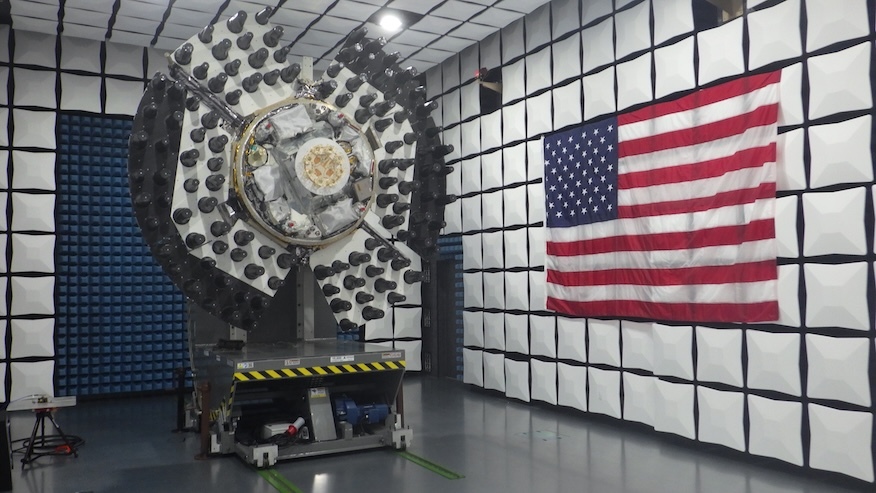24.10.2024
ULA begins stacking Vulcan rocket in anticipation of first national security mission

United Launch Alliance (ULA) hoists its Vulcan first stage booster into the Vertical Integration Facility-G (VIF-G) adjacent to Space Launch Complex-41 at Cape Canaveral Space Force Station, Florida. The rocket will launch the USSF-106 mission for the U.S. Space Force’s Space Systems Command, Vulcan’s first national security flight. Image: United Launch Alliance
Less than a month after the second of two planned certification launches, United Launch Alliance is getting a Vulcan rocket ready for its first national security mission: United States Space Force 106 (USSF-106).
On Monday, ULA shared photos of the 109.2-foot-long (33.3 m) booster being hoisted into the Vertical Integration Facility to begin the stacking process. In the days and possibly weeks to come, the 38.5-foot-long (11.7 m) Centaur 5 upper stage will be added along with four solid rocket boosters and the payload fairings.
The beginning of the rocket’s integration comes as the U.S. Space Force continues to review data from the Cert-2 mission, which launched on Oct. 4 from Space Launch Complex 41 (SLC-41) at Cape Canaveral Space Force Station.
“You don’t have to be certified before you start all of the activities that are involved in getting a payload ready and planning its mission and integrating it,” said ULA President and CEO Tory Bruno during a media teleconference prior to the launch of Cert-2. “That work is already underway. We just can’t fly it until we’re certified and I would say my customer would be reluctant to physically integrate it to the rocket, stick it on the rocket until that is done either.”
During an Oct. 14 appearance at the International Astronautical Congress in Milan, Italy, Bruno discussed the issue that came up with one of the solid rocket boosters (SRBs) during the Cert-2 flight less than a minute after liftoff.
The booster’s nozzle popped off, forcing the rocket to adjust the output from the Blue Origin-built BE-4 engines to compensate. He noted that the SRB in question continued to fire, but with less efficiency than normal, according to Space News.
“The net effect of that was less than two percent of the total impulse of the booster,” Bruno said.
ULA confirmed the investigation is ongoing. The company has a total of 35 SRBs being stored for future missions, which are a combination of GEM 63s for Atlas 5 rockets and GEM 63XLs for Vulcan rockets.
During his prelaunch remarks, Bruno said the anticipated timeline to full certification shouldn’t be long, if they had a “very clean mission.” He said in that scenario, “it’s a short number of weeks to get it all done,” referring to the analysis required for certification.
Because the Sierra Space Dream Chaser spaceplane wasn’t ready in time for the Cert-2 launch, ULA completed that mission with an inert payload that included some experiments designed to gather data on the performance of the Centaur 5 upper stage.
The USSF-106 mission will feature the first fully-government payload that ULA will fly on a Vulcan rocket. While the Cert-1 launch featuring Astrobotic’s Peregrine lunar lander was part of NASA’s Commercial Lunar Payload Services (CLPS) program and featured some NASA payloads, it was explicitly considered as a commercial mission.
Nevertheless, with the successful completion of the Cert-1 mission, NASA said ULA can begin offering up Vulcan for consideration for NASA missions under the NASA Launch Services 2 (NLS-2) contract.
“The requirements for proposing on NLS-II task orders are to be on the contract and have had one successful flight,” said Jorge Piquero, the Senior Technical Integration Manager for NASA’s Launch Services Program (LSP), in an emailed statement to Spaceflight Now. “Certification is not required to bid, but will be required by the time of the awarded mission’s launch.”
As for what the U.S. Space Force is looking for through the certification process to fly missions for the National Security Space Launch (NSSL) program, the Space Systems Command’s (SSC) Assured Access to Space (AATS) program office described its approach as follows:
“The Government worked with industry to jointly develop a certification plan that outlines a three-phase approach with 25 different major categories that encompass process assessment, design and qualification hardware and software evaluation, launch site assessments, and verification and validation to meet USSF mission requirements for all mission orbits. The USSF currently expects the completion of all Vulcan certification activities in 2024.”
Vulcan’s NSSL era
Once certification is complete for the Vulcan rocket, there are two missions on deck: USSF-106 and USSF-87. ULA said it’s “working with our customers to determine the launch dates.”
Back in January, in a joint statement to Spaceflight Now, Col. Doug Pentecost, the SSC’s Deputy Program Executive Officer for Assured Access to Space, and Michael Sanjume, the senior materiel leader for Vulcan Systems and Operations, said that the USSF-106 mission would be a multi-manifest mission.
Onboard this first flight of a certified Vulcan rocket will be the Navigation Technology Satellite-3 (NTS-3) and another undisclosed payload for the U.S. Space Force.
The NTS-3 spacecraft is based on Northrop Grumman’s ESPAStar satellite bus and was developed by L3Harris Technologies. Once on orbit, it will be managed by the Air Force Research Laboratory’s Transformational Capabilities Office.
The AFRL said it features an agile positioning, navigation and timing (PNT) payload “to provide a space platform for AFRL and partner organization experiments and integrated capability demonstrations.” The spacecraft is designed to operate for one year in a near-geosynchronous orbit.
“NTS-3 builds on the legacy of NTS-1 and NTS-2, which were launched in the 1970’s, and it will push the boundary of today’s space-based position, navigation, and timing (PNT) technology to pave the way for a more robust, resilient, and responsive architecture for satellite navigation (SATNAV) technology,” the AFRL said in a statement.
The satellite serves as a backstop for the U.S. Space Force’s Global Positioning System (GPS) by creating resiliency against attempts to jam or spoof GPS. The NTS-3 features multiple atomic clocks to allow for “automatic clock error detection and correction” since the satellite’s SATNAV is “critically dependent on precise timekeeping.”

The Navigation Technology Satellite-3, or NTS-3, spacecraft is shown in an anechoic test chamber prior to electromagnetic interference and electromagnetic compatibility testing in Palm Bay, Florida. This experimental satellite is being designed, built and tested by L3Harris Technologies, and will be used by the Air Force Research Laboratory and partner organizations as part of an integrated system to conduct a one-year demonstration of advanced technologies and concepts in satellite navigation. Image: L3Harris Technologies
The AFRL said there are three mutually-interdependent systems that tie into the NTS-3 demonstration mission:
- A space-based experimental satellite
- Ground-based command and control system
- Agile software-defined user receivers (SDR)
“Ultimately, user equipment is where the impact of new navigation technologies and integrated SATNAV capabilities are felt by our warfighters and any changes to the signal being broadcast from space must be communicated to and coordinated with the user segment,” the AFRL wrote.
“NTS-3 will demonstrate new SDR features and the ability to effectively perform on-orbit reprogramming across system segments during the experimental mission, including various signal modulations, transmitting data in different ways, and changing broadcast parameters on a pre-defined schedule.”
According to L3Harris, the satellite features five main components:
- Active Electronically Steerable Phased Array (AESA)
- Agile Waveform Platform (AWP), consisting of Enhanced Signal Processors (ESP) and Ground Mission Applications (GMA)
- Cion Antenna/Receiver, created in partnership with NASA’s Jet Propulsion Laboratory
- Hosted Payload Processor (HP2)
- Modular, Scalable Bus-agnostic Payload
While the exact price of the mission is proprietary to ULA, according to the original task order awardannounced in August 2020, the two mission awarded to ULA at the time (USSF-51 and USSF-106) had a combined value of $337 million.
In the batter’s box
Following the USSF-106 mission will be USSF-87, which was originally scheduled to launch in the fourth quarter of FY23, according to the SSC’s original announcement of its assignment to ULA in March 2021.
As first reported by Aviation Week, the payload for this mission is expected to be a pair of satellites for the Geosynchronous Space Situational Awareness Program (GSSAP).
“GSSAP satellites collect space situational awareness data allowing for more accurate tracking and characterization of man-made orbiting objects,” according to the U.S. Space Force. “From a near-geosynchronous orbit, it has a clear, unobstructed and distinct vantage point for viewing Resident Space Objects (RSOs) without the interruption of weather or the atmospheric distortion that can limit ground-based systems.”
The first pair of these satellites was launched from Cape Canaveral more than a decade ago on July 28, 2014, and achieved operational capability status on Sept. 29, 2015. Since then there have been two additional launches of satellite pairs in 2016 and 2022.
An Aug. 2023 press release from the U.S. Space Force’s Space Operations Command (SpOC) announced that two additional launches were scheduled for 2024 and 2027.
“The capabilities provided by GSSAP aid safety and enable avoidance as we operate in space,” said Mr. Mike Anthony, Space Operations Command Mission Area Team Chief, in the release. “Space is essential to our security and prosperity and is part of our everyday life. Our ability to operate safely and effectively is not only integral to global interests but is also vital to national defense.”
Competing with SpaceX
While all 50 missions in the NSSL Phase 2 already awarded between ULA and SpaceX, the competition for launches under the new NSSL Phase 3 is now underway. The task orders are split into two main buckets: Lane 1 and Lane 2.
NSSL Phase 3 Lane 2 task orders will be partitioned similarly to Phase 2, in which about 60 percent will go to one launch provider, 40 percent to another and seven missions will be set aside for a third entrant. The awardees will be those who are able to send payloads to any orbital regime required by the U.S. Space Force and/or the National Reconnaissance Office.
Lane 1 meanwhile will see task order awards issued annually, which is designed to allow for more robust and regular competition to help diversify the launch market. However, the first year task order was announced last week with all nine missions going to SpaceX.
These launch service task orders (LSTOs) have a total value of about $733.6 million. Seven of the missions will support the launch of the Space Development Agency’s (SDA) space vehicles as part of its Tranche 2 Transport Layer satellite constellation.
Four of those launches will lift off from Vandenberg Space Force Base and the other three will launch from Cape Canaveral Space Force Station.
